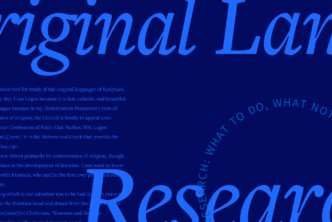Brill’s Dictionary of Ancient Greek is now available at logos.com. Many of us Greek language geeks have been rather eagerly waiting for its digital appearance on Logos, though perhaps other Logos users might be wondering what Brill’s GE (the editors’ preferred abbreviation) can contribute to their libraries. Here are some questions that you be asking yourself already:
- How does this lexicon fit amongst my collection of lexicons?
- Is LSJM good enough or has it been surpassed?
- How does this new lexicon relate to BDAG?
These are surprisingly complicated questions.
Fifteen years ago, Eerdmans published a collection of essays in honor of Frederick W. Danker. Rather delightfully, it’s now available on Logos (Biblical Greek Language and Lexicography). The honor was certainly merited.
Without the labors of Dr. Danker, New Testament lexicography would be in a far worse off place than it is. BDAG, for the first time in its history of revision in both English and German, added actual definitions to its lexical entries rather than mere translational glosses, in addition to the over 15,000 new citations included in the entries, as well as entirely new, more-readable formatting. The merits of BDAG are well known, and Logos’ product page for BDAG includes links to the multitude of reviews that were published in the Review of Biblical Literature articulating these merits.
Still, the state of Ancient Greek lexicography is not all roses, even though the lexicons of Biblical and Christian literature are rather more robust than others. Classicist William A. Johnson observed in his contribution to Danker’s festschrift that when he looks at lexicons for Latin compared to Greek, the contrast between them is, well, perhaps a bit uncomfortable.
“Indeed, it is interesting to reflect upon the difference in the attitude which a Classicist brings to the reading of a Greek text versus the attitude which he or she brings to the reading of a Latin text. When looking up a Latin word in a classical text, I expect some rather precise information — certainly a good conspectus of possible translation equivalents. Even a humble dictionary like Traupman’s New College Dictionary is often remarkably good for such a purpose; and the Oxford Latin Dictionary (OLD) is excellent. I also expect reliable and full exposition of possible syntactic constructions, and of fixed or typical expressions. The OLD is usually good here too, at least within its restricted time period, and the Thesaurus linguae Latinae (ThLL) is simply magnificent. But then one turns to Greek. We have not walked into a slum exactly, but the buildings are more closely spaced, the porch banisters often rickety, the lawns not so well kept. Approaching the dictionary, a Hellenist must remain cautious and light on the feet. Often enough none of the translation equivalents is exact for a given context; sometimes the definition is simply wrong; glosses are rather frequently wrong (at least by contemporary interpretation); information on syntax, typical expressions, orthographica, or dialectical forms is hit-or-miss; and the overview one gets of the word can be fundamentally flawed, since, lexicographical practice aside, the passages considered by the lexicographer were too few and too skewed in the types of material.”
But for Johnson, this problem was fundamentally one of corpus size. The state of Greek lexicography is what it is because there are too many Ancient Greek texts that something must be sacrificed in the effort.
Here are some basic facts that Johnson lays out (77-78):
- The Oxford Latin Dictionary was made from scratch, it was a fresh look at the lexicographical material. But despite its relatively small corpus (Latin texts up to AD 200), the project took nearly 50 years to finish. It was begun in 1933 and completed in 1982, the 2nd edition published in 2012.
- The Thesaurus Linguae Latinae, the Latin equivalent of the Oxford English Dictionary, is designed to be comprehensive for the language up to AD 600. It was begun in 1894, and it hasn’t been finished yet. Johnson estimated no earlier than 2035 for a completion date back in 2004, but it’s more likely to not be finished until at least 2050.
- The Greek corpus, as laid out by the TLG, is roughly six times larger than the Latin corpus. Even if the work could be done several times faster, such a dictionary would not be finished for centuries.

And so, Greek lexicographers continue in the tradition that they have for generations: revising old dictionaries. Indeed, the lineage of revision for LSJM (and, in turn, now Brill’s GE) goes all the way back to the Byzantine period. Correcting some problems, adding new words, accounting for new texts, citing new literature, but really only piecemeal changes.
And all the while, they never directly engage with the larger problems being perpetuated in our Greek lexicons and dictionaries. Those problems have been articulated well by John A. L. Lee, both in his larger monograph, A History of New Testament Lexicography (a far more entertaining book than the topic deserves!) and also briefly in his own contribution to Frederick Danker’s festschrift: “The Present State of Lexicography of Ancient Greek.”
Coverage of texts is sporadic at best:
- The classical period is well represented. LSJM was originally designed to cover this period and this is where it is strongest. Beyond that it has limited coverage of post-classical texts and is often unreliable.
- The Biblical/Christian corpus is well covered by its own lexicons, but only for itself, not for the larger historical era. That is, BDAG is not a lexicon of Koine Greek. It is a lexicon of early Christian literature. One cannot rely on it for the Old Testament Pseudepigrapha, Josephus, or various literary authors of the 1st or 2nd centuries. The same is true of Muraoka’s Septuagint lexicon, which is not currently available in Logos. Unlike BDAG, however, it has the advantage of being a fresh, original work, but it does not provide citations or evidence outside the Septuagint. It is also, then, not useable as a lexicon of the general historical era.
- Using lexicons for the church fathers or the papyri in Greek is a haphazard experience. In Logos, there is only Sophocles’ lexicon, Greek Lexicon of the Roman and Byzantine Periods. Its coverage is large, but it is little more than a glossary. Outside Logos Bible Software, we have Lampe’s Patristic Greek Lexicon, but it is an odd work that is designed to function in concordance with LSJM. Lampe only adds new patristic information to the existing entries in LSJM.
Given this context, Brill’s new lexicon, GE, is a huge step up. Brill has greatly expanded citations of toponyms–geographic locations such as cities, as well as personal names. Parsing information for unusual or unexpected verb forms is greatly improved as well. But most important is the addition of more post-classical vocabulary, such as ζηγήμων ‘burning’ or ζιζανιώδης ‘like tares’–tares are a kind of vegetable crop–both citing Gregory of Nazianzus, or ζητουμένως, ‘controversially, questionably’ citing John Chrysostom. As Logos builds out its collection of more and more Greek texts, particularly for later periods of the language, this sort of improved coverage will become increasingly valuable.
But this new dictionary also borrows a lot of material from LSJM. Its historical roots, after all, do stretch back to LSJM. Franco Montanari has been the steward over improvements to the Italian edition since 1989, and with the added contributions of Madeleine Goh and Chad Matthew Schroeder, we are now able to enjoy his contributions in English. Yet faced with the same daunting task as all Greek lexicographers of having too much material, these three scholars, both in English and Italian, were obliged picked their battles.




